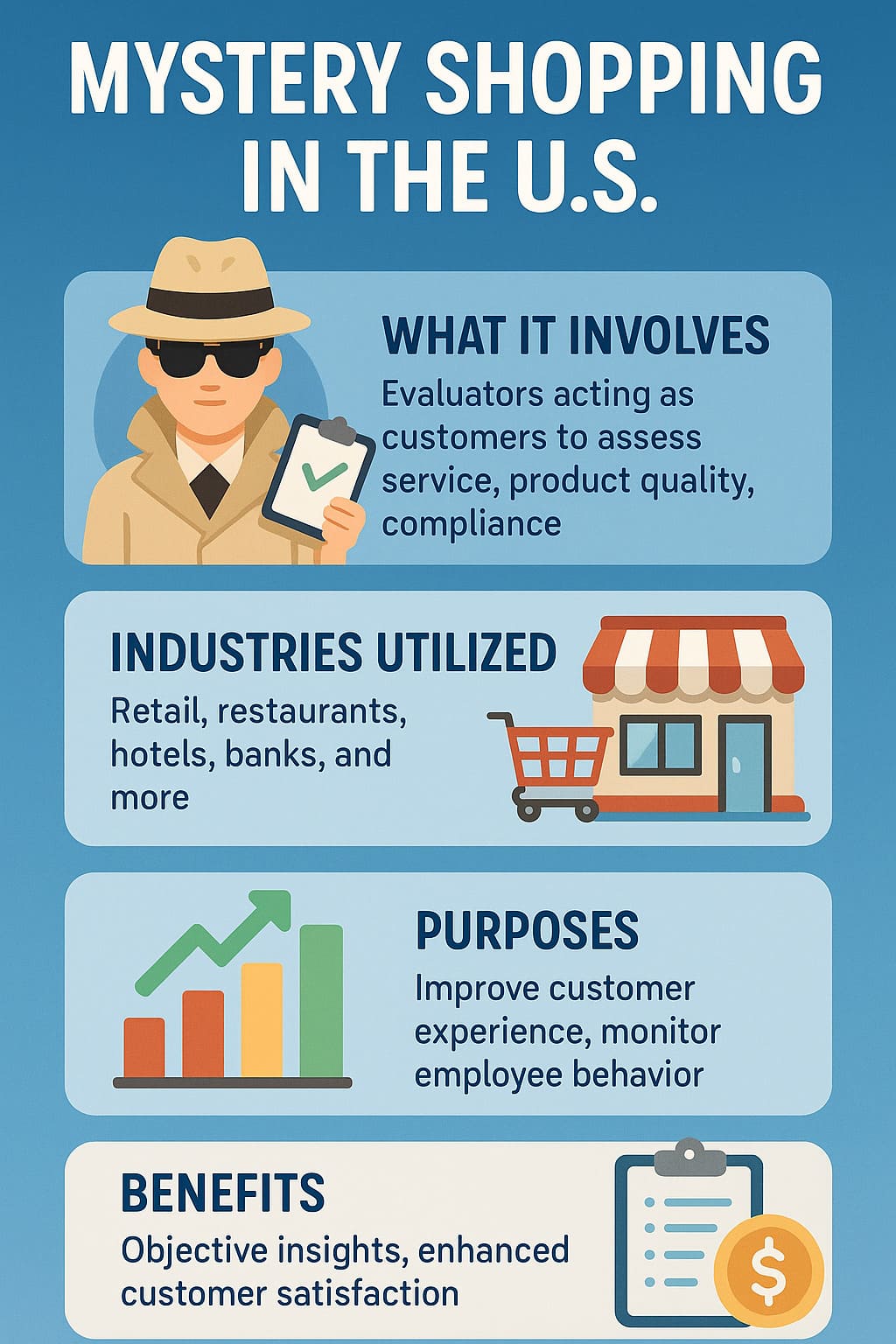Mystery Shopping in the US

The customer experience battleground is bloodier than ever, yet most American businesses have absolutely no clue what’s happening on their front lines. It’s madness.
This is the essential reality check in a landscape where one negative experience explodes across social media within minutes, potentially erasing years of brand building overnight… And most organizations aren’t ready for this uncomfortable truth.
Table of Contents
✅ Listen to this PODCAST EPISODE here:
The Uncomfortable Reality Check in Mystery Shopping in the US
The smartest companies aren’t wasting mystery shopping budgets on themselves. They’re systematically dissecting competitors’ experiences, stealing what works, and avoiding what doesn’t.
The US mystery shopping industry is worth (at least) $600 million annually… Big number, right? Too bad most of it is wasted on reports nobody reads and insights nobody acts on.
Additionally, most businesses claim they’re creating “seamless experiences.” What a joke! Their mystery shopping programs evaluate channels in isolation, missing the broken handoffs that are killing customer loyalty.
Tech also plays a big role in this area. Traditional clipboard-wielding mystery shoppers are dinosaurs. The real players are leveraging machine learning to analyze emotional micro-expressions your staff doesn’t even know they’re making. The companies crushing it are using biometric mystery shopping that tracks pupil dilation, galvanic skin response, and vocal stress patterns. Your quarterly “shopper scored us 4/5 on greeting” report is already obsolete.
The Psychological Warfare Most Companies Are Losing

Your company has probably developed elaborate psychological defense mechanisms that filter out customer experience realities that challenge internal narratives. It happens everywhere from the boardroom to the stockroom.
Think I’m being dramatic?
The most profound mystery shopping in the US studies aren’t even labeled as such. This cognitive bias is the silent killer of customer experience initiatives. And it’s why most mystery shopping programs deliver abysmal ROI.
The painful truth? Most American businesses have built impenetrable fortresses against the very insights they claim to seek. Middle managers filter out damaging findings before they reach senior leaders. Senior leaders cherry-pick metrics that confirm their strategic brilliance. And everyone collectively participates in elaborate theater pretending to be “customer-obsessed” while systematically ignoring what customers actually experience.
But there’s a counterintuitive twist to this mess.
The organizations extracting extraordinary value from mystery shopping in the US aren’t the ones with the biggest budgets or the fanciest methodologies. They’re the rare breeds with the psychological capacity to embrace uncomfortable truths. They’ve cultivated what psychologists call “institutional humility” – the organizational ability to say “we got this wrong” without triggering defensive routines.
Why Your Mystery Shopping in the US Program Is Probably a Waste of Money
Your organization’s capacity to benefit from mystery shopping is inversely proportional to how badly you need it.
Let that sink in for a moment.
Companies with significant customer experience problems typically have entrenched cultural and leadership issues that make them resistant to the very insights that could save them. Meanwhile, organizations already delivering exceptional experiences are psychologically open to feedback and quick to implement improvements – even though they need it less.
It’s a cruel paradox that explains why so many mystery shopping initiatives crash and burn.
The most revealing pattern is how organizational hierarchy distorts customer experience reality. In rigidly hierarchical companies, negative mystery shopping findings get progressively filtered and diluted as they move up the chain. By the time they reach decision-makers, they’ve been sanitized beyond recognition.
But that’s just the beginning of the dysfunction.
The organizational psychology explains everything. Most companies have built their identity around being customer-focused. When mystery shopping reveals significant gaps between this identity and reality, it triggers an existential threat response. The organization mobilizes its immune system to attack, discredit, or neutralize the threatening information rather than metabolize it.
This psychological reality requires a complete rethinking of how mystery shopping programs should be designed and implemented. The traditional approach focuses almost exclusively on methodology – what to measure and how to measure it. But the breakthrough insight is that implementation psychology matters far more than methodology.
The Measurement Delusion Crippling American Businesses
The explosion of customer metrics has paradoxically made organizations less attuned to customer reality by creating a false sense of understanding. Companies confuse measurement with insight.
Most companies believe they understand their customer experience because they’re drowning in metrics. NPS scores. CSAT ratings. Customer effort measurements. Online reviews. Social sentiment. The dashboard looks impressive. The quarterly trends get presented. Everyone nods thoughtfully.
It’s all a sophisticated illusion.
These metrics create the comforting sensation of understanding without delivering actual insight. They tell you whether customers are happy or unhappy, but reveal almost nothing about why. They’re lagging indicators that describe outcomes without illuminating causes.
This is where properly executed mystery shopping cuts through the delusion.
While traditional metrics tell you what happened, mystery shopping reveals why it happened. That’s the critical difference most organizations miss. Mystery shopping is a completely different category of intelligence that excavates the causal mechanisms behind your performance metrics.
The organizations extracting maximum value from mystery shopping understand this fundamental distinction. They don’t treat it as a scorecard but as a diagnostic instrument that reveals the hidden psychological, structural, and operational factors that ultimately determine customer experience.
The measurement delusion extends beyond confusing metrics with insights. It also manifests in how organizations structure their evaluation criteria. Most mystery shopping programs reflect internal priorities rather than customer priorities – measuring what the organization values instead of what customers value.
The Technology Disruption Nobody Saw Coming
The technological revolution reshaping mystery shopping isn’t incremental – it’s existential. And it’s happening at breakneck speed.
Traditional mystery shopping in the US relied on human observers manually recording experiences against standardized criteria. This approach is being rapidly displaced by systems that continuously harvest vast realms of behavioral and sentiment data, then deploy AI to identify patterns invisible to human analysis.
The transformation is happening across three waves:
The first wave – which most of the industry has at least acknowledged – involves augmenting human evaluators with digital tools. Video mystery shopping. Mobile evaluation platforms. Geolocation verification. These enhance traditional approaches without fundamentally challenging the underlying model.
The second wave – which is splitting the industry into innovation leaders and legacy laggards – leverages big data and AI to create continuous evaluation systems. These platforms synthesize customer interaction recordings, social sentiment, review analytics, and transaction data to provide dynamic rather than episodic evaluation. The leaders here aren’t mystery shopping companies but customer intelligence platforms that have expanded into experience evaluation.
The third wave – which will likely render traditional mystery shopping obsolete within 5-7 years – leverages biometric and neurological measurement to assess customer experience at a subconscious level. Eye-tracking technologies that measure pupil dilation in response to service interactions. Voice analysis systems that detect emotional states through micro-variations in vocal patterns. Facial recognition platforms that identify emotional responses through micro-expressions.
This technological disruption creates an uncomfortable reality for the mystery shopping industry: the traditional “shopper” will likely become obsolete, replaced by experience analysts who design evaluation frameworks and interpret AI-generated insights rather than personally conducting evaluations.
The providers who survive this transition will be those who recognize they’re not in the data collection business but in the insight generation business. The means of collection are changing radically, but the need to translate raw data into actionable intelligence remains constant.
The Implementation Secrets
The organizations extracting maximum value from mystery shopping in the US share several counterintuitive implementation practices that dramatically outperform conventional approaches:
1. They separate measurement from judgment
Most companies make a catastrophic psychological error – they use mystery shopping scores to judge performance rather than understand it. This instantly creates defensive responses that block actual improvement.
The breakthrough organizations establish a fundamentally different psychological contract. They position mystery shopping as a diagnostic tool to understand system performance rather than a weapon to evaluate individual performance.
2. They investigate patterns, not incidents
Average organizations obsess over individual mystery shopping evaluations – particularly negative ones. They launch investigations, identify “what went wrong,” implement narrow fixes for specific incidents, and then wonder why system performance doesn’t improve.
Superior organizations ignore individual evaluations and focus exclusively on patterns across hundreds or thousands of data points. They understand that customer experience is an emergent property of complex systems rather than a series of isolated incidents.
3. They create insight democracy rather than insight aristocracy
In most organizations, mystery shopping in the US insights stop at middle management. Frontline employees – those actually creating the customer experience – receive simplified scorecards or watered-down findings rather than rich, contextual understanding.
The organizations achieving breakthrough results demolish this insight hierarchy. They share complete, unfiltered mystery shopping insights with everyone from the CEO to frontline staff.
4. They focus on driver metrics, not outcome metrics
Traditional mystery shopping programs emphasize outcome metrics – overall satisfaction, likelihood to recommend, etc. These create virtually no actionable intelligence because they describe results without illuminating causes.
The most effective organizations ruthlessly focus on driver metrics – the specific operational, behavioral, and psychological factors that create customer experience outcomes. They use sophisticated statistical analysis to identify which elements most directly influence customer perceptions, then concentrate improvement efforts on these high-leverage factors.
5. They integrate mystery shopping into strategic decision-making
In average organizations, mystery shopping exists in a customer experience silo, disconnected from core business strategies and executive decision-making. Findings might influence service training but rarely impact product development, pricing strategies, or market positioning.
The organizations extracting maximum value position mystery shopping as strategic intelligence that informs decisions across functions and levels. They recognize that customer experience insights predict financial performance more accurately than traditional metrics and integrate these insights into every major strategic decision.

Key Takeaways: The Strategic Reality of Mystery Shopping in the US
✅ Mystery shopping in the US represents a $600 million industry that’s simultaneously overutilized and underleveraged by American businesses.
✅ Implementation psychology—not methodology—separates market leaders from laggards in US mystery shopping effectiveness.
✅ The most successful programs focus on understanding systems rather than judging individuals, prioritizing patterns over isolated incidents.
✅ American companies leveraging mystery shopping as strategic intelligence consistently outperform those using it merely as a compliance tool.
✅ Technological integration (AI, biometrics, predictive analytics) is making traditional US mystery shopping approaches obsolete.
✅ Despite technological advances, the fundamental success factor remains organizational readiness to confront uncomfortable truths.
✅ The future of mystery shopping in the US belongs to organizations that view customer experience as a complex adaptive system requiring sophisticated intelligence capabilities.
What Makes SIS International a Top Mystery Shopping Company in the US?
Most mystery shopping providers make the same empty promises. But SIS International operates in a completely different league – and I’ve spent enough time analyzing this industry to spot the real players from the pretenders.
What makes เอสไอเอส อินเตอร์เนชั่นแนล the standout choice for companies that actually want transformative insights rather than checkbox exercises?
- Methodology Architects, Not Template-Pushers: Most providers force your business into their standardized approach. SIS does the opposite – designing bespoke research methodologies around your specific challenges and customer journeys. This custom-built approach to market research means you’re getting intelligence that actually matters to your business, not generic scoring against arbitrary standards.
- Four Decades of Pattern Recognition: In an industry cluttered with overnight experts, SIS brings over 40 years of accumulated wisdom. That’s not just about experience – it’s about having observed customer behavior through multiple economic cycles, technological revolutions, and psychological shifts in American consumers.
- Recruitment Engine That Actually Works: The dirty secret in mystery shopping? Most providers struggle to find qualified evaluators, especially for specialized industries or geographic areas. SIS maintains proprietary recruitment databases that ensure you’re getting evaluators who actually match your customer demographic and can provide relevant insights, not whoever happened to respond to a Craigslist ad.
- Speed Without Sacrificing Rigor: In today’s market, insights delivered next quarter are often worthless. SIS has developed streamlined execution processes that deliver intelligence when you can actually use it, without compromising methodological integrity.
- Value Engineering Not Price Gouging: Unlike providers who reserve their best methodologies for enterprise clients with unlimited budgets, SIS structures programs that deliver maximum insight value regardless of investment level.
- Systems Thinkers Not Checkbox Fillers: The fatal flaw in most mystery shopping? Treating customer experience as isolated interactions rather than an interconnected system. SIS integrates mystery shopping with broader ข่าวกรองตลาด to reveal how your customer experience fits within competitive dynamics, market positioning, and consumer expectations – creating context that standalone evaluations simply cannot provide.
- Analytics That Actually Reveal Something: If your mystery shopping reports are filled with meaningless aggregate scores and surface-level observations, you’re working with the wrong provider. SIS leverages advanced analytics to identify correlation patterns, psychological drivers, and predictive indicators that transform raw observations into strategic intelligence your organization can actually use.
คำถามที่พบบ่อย
Is mystery shopping in the US just glorified spying on employees?
The American business landscape is littered with mystery shopping programs that devolve into dystopian workplace surveillance. These toxic implementations destroy trust, create paranoia, and typically produce zero improvement in customer experience. But effective mystery shopping in the US isn’t about catching employees violating policies – it’s about evaluating system effectiveness.
The ethical distinction that separates successful programs from failures? Mystery shopping in the US should evaluate the effectiveness of customer experience systems, not judge individual employee performance. When American companies position mystery shopping as a system improvement tool with full transparency about methodology and purpose, it builds organizational trust rather than eroding it.
What’s a realistic budget for effective mystery shopping in the US?
Most American mystery shopping providers dodge this question because they’re trying to sell something. The uncomfortable truth about mystery shopping in the US? Program cost has almost no correlation with program value. The determining factor isn’t investment level but organizational readiness to act on insights.
The breakthrough insight about mystery shopping in the US: The ROI correlation with investment follows an inverted U-curve. Under-investment creates insufficient data for reliable insights, while over-investment often produces analytical paralysis and implementation bottlenecks in American organizations.
Which certifications actually matter for mystery shopping providers in the US?
The American mystery shopping industry has created a dizzying array of certifications and standards. Most are membership dues disguised as quality indicators rather than meaningful differentiators of mystery shopping in the US.
The Mystery Shopping Professionals Association (MSPA) provides baseline legitimacy for US providers, but membership alone reveals almost nothing about capability. Many member companies deliver mediocre mystery shopping in the US while following all standards, while some non-member boutique firms produce extraordinary insights without formal certification.
When evaluating mystery shopping in the US, the certifications that actually predict provider quality aren’t industry-specific but methodology-related: advanced training in research design, statistical analysis, behavioral psychology, and systems thinking. These capabilities matter far more than industry-specific certifications in the American market.
How do American businesses prevent staff from identifying mystery shoppers?
The conventional approaches to mystery shopping in the US – varying shopper demographics, randomizing visits, using different scenarios – are necessary but insufficient. Determined employees in American businesses can still identify evaluators through behavioral patterns that even sophisticated rotation systems can’t eliminate.
The breakthrough approach to mystery shopping in the US? Make identification irrelevant rather than impossible.
The most effective mystery shopping programs in the US establish a fundamental psychological principle: “We should deliver the same experience whether we know we’re being evaluated or not.” They accomplish this by aligning mystery shopping criteria with their service values rather than creating special “evaluation behaviors” that differ from normal operations.
Can digital experiences be effectively evaluated through mystery shopping in the US?
Yes, but the methodological requirements for digital mystery shopping in the US differ dramatically from physical evaluations, and most American providers haven’t adapted appropriately.
The central challenge in digital mystery shopping in the US isn’t methodology but matching. Physical mystery shoppers can reasonably approximate the demographic and behavioral characteristics of your actual American customers. Digital mystery shoppers often cannot replicate the device environments, browsing patterns, and purchase histories that shape personalized digital experiences for US consumers.
The most sophisticated digital mystery shopping programs in the US address this challenge through technical environment replication – creating digital personas with browsing histories, device characteristics, and behavior patterns that mirror actual American customer segments. This requires technical capabilities most traditional US mystery shopping providers simply don’t possess.
What’s the optimal frequency for mystery shopping in the US?
The conventional wisdom about mystery shopping in the US suggests consistent monthly or quarterly evaluations across all locations. This calendar-driven approach is methodologically convenient but strategically misguided for American businesses.
The breakthrough approach to mystery shopping in the US implements dynamic frequency based on performance variability rather than calendar convenience. American business locations demonstrating high performance consistency might receive quarterly evaluations, while those showing significant variance or underperformance receive monthly or even weekly assessments.
This dynamic approach to mystery shopping in the US concentrates resources where they deliver maximum insight value rather than spreading them evenly across all locations regardless of need. It also creates a powerful incentive system – locations can “earn” reduced evaluation frequency through consistent performance.
สถานที่ตั้งโรงงานของเราในนิวยอร์ก
11 E 22nd Street, ชั้น 2, นิวยอร์ก, NY 10010 T: +1(212) 505-6805
เกี่ยวกับ เอสไอเอส อินเตอร์เนชั่นแนล
เอสไอเอส อินเตอร์เนชั่นแนล เสนอการวิจัยเชิงปริมาณ เชิงคุณภาพ และเชิงกลยุทธ์ เราให้ข้อมูล เครื่องมือ กลยุทธ์ รายงาน และข้อมูลเชิงลึกเพื่อการตัดสินใจ นอกจากนี้เรายังดำเนินการสัมภาษณ์ การสำรวจ การสนทนากลุ่ม และวิธีการและแนวทางการวิจัยตลาดอื่นๆ ติดต่อเรา สำหรับโครงการวิจัยการตลาดครั้งต่อไปของคุณ

